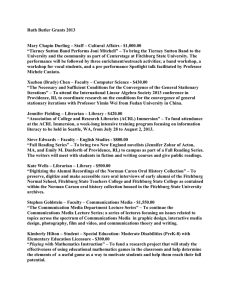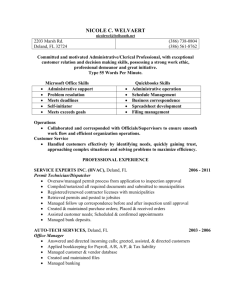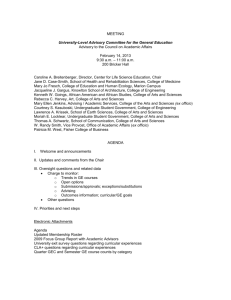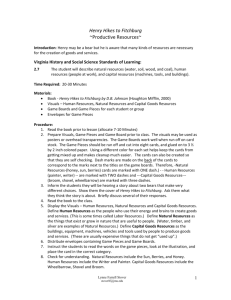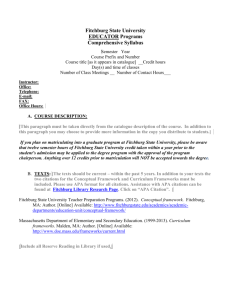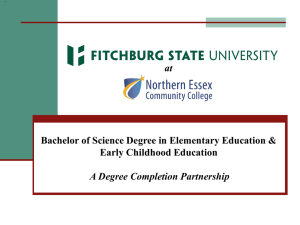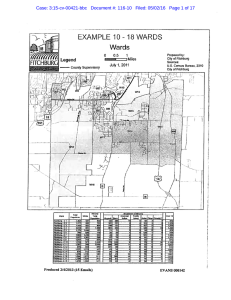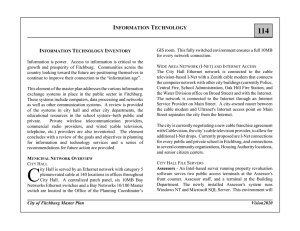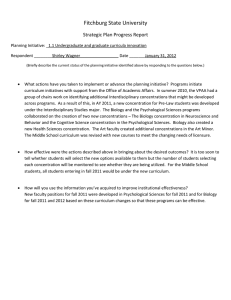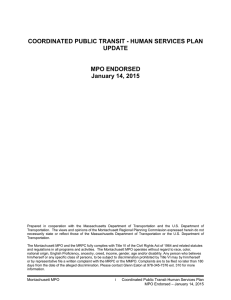Preface In 2014, the Fitchburg State University community began a
advertisement
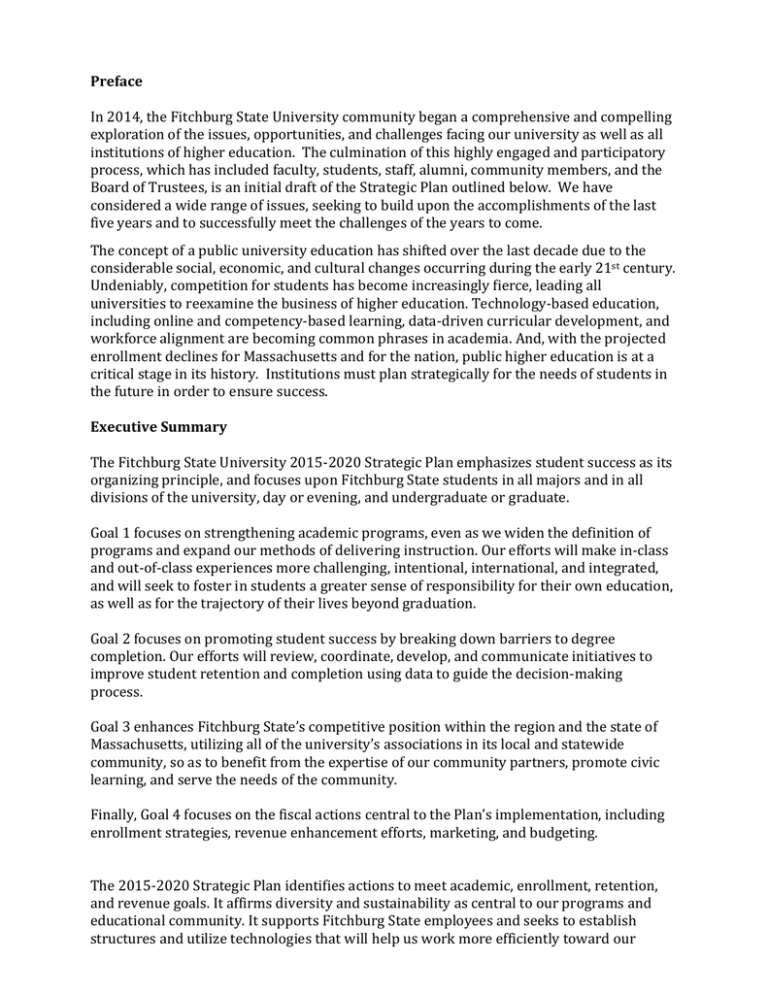
Preface In 2014, the Fitchburg State University community began a comprehensive and compelling exploration of the issues, opportunities, and challenges facing our university as well as all institutions of higher education. The culmination of this highly engaged and participatory process, which has included faculty, students, staff, alumni, community members, and the Board of Trustees, is an initial draft of the Strategic Plan outlined below. We have considered a wide range of issues, seeking to build upon the accomplishments of the last five years and to successfully meet the challenges of the years to come. The concept of a public university education has shifted over the last decade due to the considerable social, economic, and cultural changes occurring during the early 21st century. Undeniably, competition for students has become increasingly fierce, leading all universities to reexamine the business of higher education. Technology-based education, including online and competency-based learning, data-driven curricular development, and workforce alignment are becoming common phrases in academia. And, with the projected enrollment declines for Massachusetts and for the nation, public higher education is at a critical stage in its history. Institutions must plan strategically for the needs of students in the future in order to ensure success. Executive Summary The Fitchburg State University 2015-2020 Strategic Plan emphasizes student success as its organizing principle, and focuses upon Fitchburg State students in all majors and in all divisions of the university, day or evening, and undergraduate or graduate. Goal 1 focuses on strengthening academic programs, even as we widen the definition of programs and expand our methods of delivering instruction. Our efforts will make in-class and out-of-class experiences more challenging, intentional, international, and integrated, and will seek to foster in students a greater sense of responsibility for their own education, as well as for the trajectory of their lives beyond graduation. Goal 2 focuses on promoting student success by breaking down barriers to degree completion. Our efforts will review, coordinate, develop, and communicate initiatives to improve student retention and completion using data to guide the decision-making process. Goal 3 enhances Fitchburg State’s competitive position within the region and the state of Massachusetts, utilizing all of the university’s associations in its local and statewide community, so as to benefit from the expertise of our community partners, promote civic learning, and serve the needs of the community. Finally, Goal 4 focuses on the fiscal actions central to the Plan’s implementation, including enrollment strategies, revenue enhancement efforts, marketing, and budgeting. The 2015-2020 Strategic Plan identifies actions to meet academic, enrollment, retention, and revenue goals. It affirms diversity and sustainability as central to our programs and educational community. It supports Fitchburg State employees and seeks to establish structures and utilize technologies that will help us work more efficiently toward our educational objectives. It identifies steps that will enable the university to build upon its human capital and the productive relationships among its various faculty, staff, and student cohorts. It advances the core values and the mission statement of Fitchburg State University, and it moves us forward with purpose and direction. Implementation Principles & Timelines Several essential principles will govern the Plan’s implementation: 1. 2. 3. 4. The focus on student success will permeate all aspects of this plan Civility and respect will guide all discussions and decision making Decision-making processes will involve all relevant stakeholders Effective implementation will depend on clear and timely communication of rationales and goals 5. Economic feasibility—including the maintenance of net revenues—will be required The implementation of a strategic plan occurs throughout its life cycle, and this draft cannot fully determine the Fitchburg State Strategic Plan’s implementation. The President and the Executive Cabinet will discuss implementation schedules, which ultimately must be approved by the Board of Trustees. Implementation of the Strategic Plan’s elements will be coordinated by the Vice President(s) who oversees the division and/or department responsible for the action item. Implementation of the curricular and policy elements will be coordinated by the Provost and the Academic Affairs team. Any resulting curricular initiatives will be approved through the university governance processes. It is assumed that, in the final Plan, specific implementation timelines will be set for the Plan’s first eighteen months. Future timelines will be reset each year following, as conditions warrant. The current draft also assumes that implementation progress, revision recommendations, and ongoing implementation plans will be regularly reported to the university community. Goal 1. Strengthen Academic Programs We support our campus-wide emphasis on providing and communicating clear pathways to student retention and graduation through the analysis of student success data, the commitment to ongoing curricular development, the provision of comprehensive academic support services, and the utilization of proactive advising. We explore alternative pathways to degree completion by considering new and more flexible options for course delivery, including accelerated courses as well as online and hybrid learning and additional delivery options using technology. Goal 1 focuses on academic programs and curricular initiatives to realize these aims. Objective 1A. Prepare students for success in the workforce through a university education, which combines a liberal arts education and professional programs. Actions 1A: 1A1. Align Liberal Arts and Sciences core curriculum with skills and aptitudes valued in the workforce. These values include meta-cognition, critical and creative thinking, inductive and deductive reasoning, oral and written communication, ethical reasoning, social justice, problem sensitivity, and cross-disciplinary experience. 1A2. Increase collaboration in academic programs through team teaching, learning communities, interdisciplinary course development, and research opportunities and support appropriate high-impact learning experiences, including opportunities in academic and experiential settings. 1A3. Enhance mentoring by student peers, alumni, staff, and faculty with training and support to enhance connectivity, communication, and effectiveness. 1A4. Review alternate assignment course release time awards with an eye toward increasing awards for scholarly and creative activity in comparison to administrative activities. Priority may be given to increasing opportunities for involving students in faculty research. Objective 1B. Develop new, flexible curricular models to serve the needs of a changing student population. Actions 1B: 1B1. Create new, affordable, transfer 2+2 associate-to-bachelor’s-degree programs. 1B2. Create new, accelerated, 4+1 bachelor-to-master’s-degree programs. 1B3. Create at least one, new undergraduate evening and one, new undergraduate day degree program. 1B4. Create new, early acceptance programs to graduate schools. 1B5. Focus on transfer student recruitment and reverse transfer policies to ensure that more students complete degrees. 1B6. Explore competency-based models for a pilot program and enhance prior learning assessment programs such as CLEP and LECAP to accelerate degree completion. Objective 1C: Make innovative use of developing technologies appropriate for students of the 21st century. Actions 1C: 1C1. Encourage a culture of experimentation and innovation with instructional technologies through operational and structural improvements and academic initiatives. 1C2. Encourage the use of alternative educational materials to reduce the cost for students. 1C3. Develop a deliberate, holistic, institution-wide discussion concerning online learning in all modalities. 1C4. Explore the creation of instituting a regularly-assessed digital literacy standard for our students to ensure all students are prepared for the present learning environment. Objective 1D: Enhance and affirm student, faculty, and staff diversity as central to the Fitchburg State experience. Experiencing diversity expands perspectives, contributes to multicultural competence, and becomes a key element in attracting and retaining students, faculty, and staff. Actions 1D: 1D1. Initiate a process to identify appropriate, feasible methods for faculty and staff hiring and student recruitment from underrepresented groups; adopt appropriate implementation strategies to increase faculty, staff and student diversity and retention. 1D2. Identify and support appropriate and ongoing efforts to further develop multicultural competencies in students, faculty, and staff. 1D3. Increase the international student population by 20% at both the graduate and undergraduate levels. 1D4. Increase opportunities for study abroad partnerships, faculty exchanges, and trips. 1D5. Increase the enrollments of Hispanic students to equal or surpass our state peers in order to better reflect and represent the local community. 1D6. Increase the six-year graduation rate of Hispanic students to halve the current achievement gap. Goal 2. Promote Student Success by Breaking Down Barriers Goal two focuses on promoting student success by breaking down barriers to degree completion. We evaluate obstacles to retention and completion. We coordinate, develop and communicate initiatives to improve student retention and completion using data to guide the decision-making process. Objective 2A: Evaluate obstacles to retention and completion through the analysis of student data and the creation of campaigns to address identified barriers. Actions 2.A: 2A1. Effectively use data from the Student Success Collaborative (SSC) to identify opportunities to break down barriers to student success. 2A2. Continue to refine the approach to remedial education to reduce the need for, and time spent in, courses which do not count toward graduation. 2A3. Explore the use of professional advising to build a foundation of student success. 2A4. Build on and expand our current practice of “proactive advising” to increase student success based on data-driven target populations. 2A5. As a result of the above actions, we plan to reach and maintain a retention rate of 80%. 2A6. As a result of the above actions, we plan to increase our overall six-year graduation rate by 5%. Objective 2B: Expand the use of high-impact practices, which break down barriers to student success. Actions, 2B: 2B1. Develop a freshman year experience proposal to be presented to the AUC in the fall of 2016. 2B2. Bring cohesion to all academic programs by requiring a senior capstone experience, portfolio, or internship to align with workforce values by fall of 2016. 2B3. Increase opportunities for community-based student research, service learning, and community-based learning and develop a central university point of contact for internships under the expanded mission of the Crocker Center for Civic Engagement. Objective 2C: Ensure student support services are adequate to meet the needs of our current and future students. Actions 2C: 2C1. Examine the current model of Student and Academic Life and evaluate the utilization of resources and the function of each area to better ascertain how student services are currently delivered, decrease redundancies, and better orchestrate the delivery of services. 2C2. Examine the career services offerings to ensure proper support for students and alumni. 2C3. Provide specific training for faculty and staff regarding the needs of diverse student populations with an eye toward creating a safe and accepting campus community for all, and including topics such as health and wellness, Title IX, ADA, differentiated instruction, English Language Learners, and cultural awareness. Goal 3. Build a University Community that Embraces Civic and Global Responsibility The viability of the university is inextricably linked to the economic health and development of the city and the region. Accordingly, we are committed to high-impact practices such as service learning and internship opportunities, which have proven to be impactful to current students, supportive of the local and regional economy, and important as recruiting tools. Objective 3A: Collaborate and align with local business, industry, educational, extended campus, and cultural partners on community-based projects and internships. Actions 3A: 3A1. Support educational initiatives that extend and apply civic learning to regional, national and international settings. Stress the role of reflection in experiential learning so students are aware of and articulate about their knowledge. Promote student development of civic competencies through service or applied learning to address social, public and community concerns. 3A2. Enhance efforts by faculty, staff and administrators to use knowledge and expertise in community service to appropriate regional partners. 3A3. Develop strategies to increase and coordinate community partnerships and alumni capacities, particularly as they might embrace changing demographics, in order to provide structure and capacity for civic learning, internships, and career development. Connect with alumni early in their careers to get them involved with current students and to keep them engaged with the university. Objective 3B: Promote the economic, social, and cultural health and development of the City of Fitchburg and the region. Actions 3B: 3B1. Explore the creation of an entrepreneurship center to spur job creation. 3B2. Explore childcare opportunities at the university and in the community. 3B3. Promote the City of Fitchburg’s designation as a cultural arts district. 3B4. Expand housing opportunities for faculty, students, and staff in the university neighborhood. 3B5. Establish goals and clear procedures for welcoming community members to university facilities and cultural events. 3B6. Emphasize and expand the university’s commitment to reducing our carbon footprint, and educate the community about this commitment. Goal 4. Grow and Strategically Align Fitchburg State’s Resources Fitchburg State University’s effectiveness relies on our structures, our processes, and our programs of study. Academic excellence requires the highest feasible level of support to our students, a strategic focus on the allocation and/or reallocation of resources, and the continuation of a sustainable financial model that most effectively deploys the university’s resources. The university faces significant demographic challenges for the next five years. As a result, we must examine all operations and look for ways to mitigate expected drops in enrollment of traditional students. Objective 4A: Consistent with the academic and intellectual aspirations of Goal 1, pursue opportunities to increase existing revenue and identify new revenue streams, including new program development, recruitment, retention, and overall enrollment strategies. Actions 4A: 4A1. Identify specific multi-year enrollment targets for all student populations, which will provide sufficient funding to meet the needs of the university. 4A2. Review graduate, undergraduate day, and evening offerings to determine appropriate expansion as well as consolidation. 4A3. Expand and cultivate graduate and undergraduate Extended Campus partnerships and connections to increase course and program offerings. 4A4. Offer an extensive array of professional development opportunities such as graduate courses, workshops, and conferences for educators, business people, healthcare and other working professionals through the Center for Professional Studies (CPS). 4A5. Consider the implementation of differential fee structures for high-cost, highdemand courses and programs. 4A6. Explore the viability of increased recruitment of out-of-state students. 4A7. Collaborate systemwide to find different paths for students to complete degrees. 4A8. Close the structural budget deficit through reductions in spending, increased efficiencies, and/or attrition. Objective 4B: Centralize and revitalize the marketing operations of the university. Actions 4B: 4B1. Identify a centralized decision maker to lead all marketing and communication efforts at the university. This individual will oversee all marketing activities with an aim at creating a fully integrated, cohesive and consistent marketing message across all offices and departments at the university and align marketing efforts with the university’s Strategic Plan. 4B2. Conduct an audit of current marketing and communications procedures to identify challenges, deficiencies, and redundancies in the current system. Objective 4C: Increase the financial resources available to the university through philanthropy, both to support Strategic Plan initiatives and to strengthen our financial position. Actions 4C: 4C1. Identify specific multi-year fundraising targets for endowment growth for endowed scholarships, faculty and program support, facilities and capital investment, unrestricted giving, and donor acquisition and retention. 4C2. Increase funding for scholarships, academic programs, and student support initiatives through foundation monies to align fundraising priorities with the Strategic Plan.
